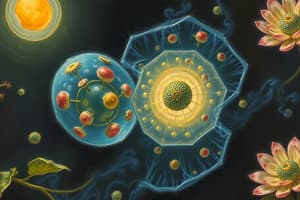Podcast
Questions and Answers
What is the primary reason cells require a specific set of conditions to function normally?
What is the primary reason cells require a specific set of conditions to function normally?
- They acquire energy from food
- They respond to environmental changes
- They maintain homeostasis (correct)
- They provide protection and support
Shivering generates metabolic heat to help cool the body.
Shivering generates metabolic heat to help cool the body.
False (B)
What substance serves as the cooling system to remove excess heat in the body?
What substance serves as the cooling system to remove excess heat in the body?
Perspiration
Energy is stored in the bonds present in ______ molecules.
Energy is stored in the bonds present in ______ molecules.
Match the following terms with their relevant descriptions:
Match the following terms with their relevant descriptions:
Which type of cells is primarily responsible for conducting information?
Which type of cells is primarily responsible for conducting information?
Skin becomes tanned to absorb more UV radiation and protect DNA.
Skin becomes tanned to absorb more UV radiation and protect DNA.
What is the function of immune cells?
What is the function of immune cells?
The first primitive microscope was invented by __________.
The first primitive microscope was invented by __________.
Which of the following best describes the role of intestinal cells?
Which of the following best describes the role of intestinal cells?
Name one general function of the cell related to the internal environment.
Name one general function of the cell related to the internal environment.
Match the types of cells with their primary functions:
Match the types of cells with their primary functions:
Heart cells are responsible for initiating motion in the body.
Heart cells are responsible for initiating motion in the body.
Who observed cork cells under a microscope to contribute to cell theory?
Who observed cork cells under a microscope to contribute to cell theory?
Matthias Schleiden proposed that all animals are composed of cells.
Matthias Schleiden proposed that all animals are composed of cells.
What did Rudolf Virchow propose regarding cells?
What did Rudolf Virchow propose regarding cells?
The smallest structural and functional unit in all organisms is the __________.
The smallest structural and functional unit in all organisms is the __________.
Which principle states that every living organism consists of one or more cells?
Which principle states that every living organism consists of one or more cells?
Match the scientist with their contribution to cell theory:
Match the scientist with their contribution to cell theory:
Anton van Leeuwenhoek invented the first practical microscope.
Anton van Leeuwenhoek invented the first practical microscope.
Name one of the three principles of cell theory.
Name one of the three principles of cell theory.
Which statement best describes the cell theory?
Which statement best describes the cell theory?
Homeostasis refers to an organism's ability to maintain a constant external environment.
Homeostasis refers to an organism's ability to maintain a constant external environment.
Name one of the three proponents of the cell theory.
Name one of the three proponents of the cell theory.
Cells have a smaller size which helps them maintain a higher ____ to volume ratio.
Cells have a smaller size which helps them maintain a higher ____ to volume ratio.
Match the scientific concept to its definition:
Match the scientific concept to its definition:
What is one reason cells are generally small in size?
What is one reason cells are generally small in size?
Combining cells is similar to combining bricks to create a functional structure.
Combining cells is similar to combining bricks to create a functional structure.
The process of ____ refers to how an organism utilizes energy.
The process of ____ refers to how an organism utilizes energy.
Flashcards are hidden until you start studying
Study Notes
Cell Theory Overview
- Cells are the basic structural and functional units of life, much like how bricks form a structure.
- Cellular functions are essential for life processes and the maintenance of homeostasis.
Learning Objectives
- Understand and explain the postulates of the cell theory.
- Describe general cell features and create a timeline for the discovery of the cell.
- Identify key scientists who contributed to cell theory and analyze its principles.
General Features of Cells
- Cells are small to maintain a higher surface area to volume ratio, facilitating efficient nutrient exchange and waste removal.
- Homeostasis is the ability of an organism to maintain a stable internal environment, critical for proper cell function.
Functions of the Cell
- Regulation of Internal Environment: Cells monitor and adjust internal conditions.
- Acquisition and Utilization of Energy: Cells convert chemical energy from food to fuel various functions.
- Responsiveness to Environment: Cells detect changes and respond appropriately to maintain homeostasis.
- Protection and Support: Cells provide structural integrity and defense against external threats.
Historical Development of Cell Theory
- Zacharias Janssen: Inventor of the first primitive microscope.
- Robert Hooke: First to observe and name "cells" while examining cork tissue.
- Francesco Redi: Disproved spontaneous generation, advocating for biogenesis.
- Anton van Leeuwenhoek: Observed live microorganisms using his advanced microscopes.
- Matthias Schleiden: Proposed that plants are made of cells, supporting the cell theory.
- Theodor Schwann: Proposed that animals are also composed of cells.
- Rudolf Virchow: Stated that all cells arise from pre-existing cells, integrating various discoveries.
Principles of Cell Theory
- Principle 1: Every living organism is composed of one or more cells, which can be unicellular or multicellular.
- Principle 2: The cell is the smallest fundamental unit of life, essential for all biological functions.
- Principle 3: Cells originate only from other pre-existing cells, incorporating hereditary material in cell division.
Studying That Suits You
Use AI to generate personalized quizzes and flashcards to suit your learning preferences.




